Harnessing Asia’s Potential: ShContemporary 2007
Marek Claassen of Berlin based artfacts.net and TAB talked to Lorenzo Rudolf, director of ShContemporary Art Fair in Shanghai.
You said in an interview published on your website: “It is overdue that Asia has its own international top art fair.” Does that mean ShContemporary is in your eyes the Art Basel or Art Miami of the whole Pacific region?
I don’t want do an Art Basel or an Art Miami. What I want to do is something new, something special for Asia. But at the end, if you are talking about the meaning, about the importance of the fair, it is. In other words, we have a confidence that is so strong: the growth of the art scene is just incredible. China and India are only the tip of the iceberg. But I think that we have a worldwide market which is not really realising what is going on here, and which is especially not giving the necessary weight and respect. That’s the reason why I say: what we need here is a platform where we can show what is going on in this continent – show it to the entire world, but also be a platform where the entire world can come and see what is going on here. So if you look from the point of view of the importance of the fair, it might be the Art Miami of Asia. But, content-wise, we will never be a copy of Miami or of Basel.
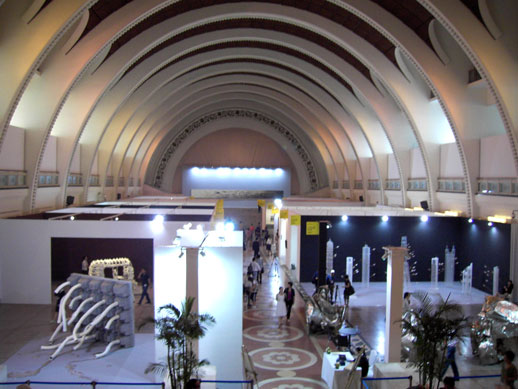
You also said that an art fair like yours is as an opportunity for lucrative first access to works by future stars. Do you mean that international art fairs function as a booster for the primary art market in the way that auction houses do for the secondary market?
First of all, I have to compliment you on how well prepared you are! It seems that you have read all of my interviews! I think it’s clear: an art fair like this should first of all support the primary market. That’s one thing. The second thing is: it’s important to think about the content of an art fair, especially in a time when you have art fairs popping up like mushrooms in the September rain. And in addition to that, there are so many similar art fairs! Every art fair tries to invite the same galleries, the galleries with the same artists… The criterion all over the world at the moment is market ability, a ‘what can I sell?’ frame of mind. In such a situation, even if you go to important art fairs nowadays, you can hardly find and discover genuinely new things. But what every collector wants is to discover. He wants to find new things. Here we try to present the entire creativity of this continent, and there are a lot of new things that are not known in the international market. But with the rising importance of Asia and the Asian art scene that wants to be an important future player in the market, you really have the opportunity to discover and to have access to works and to new rising stars. We want to help these artists break into the international market.
There a many fairs out there and a lot of them are trying to reach the top level by inviting the same galleries over and over – something you said you wanted to avoid. By checking the origin of the galleries invited I found that 25% are also in Basel and 20% are attending ARCO and FIAC. How does this go together?
There are two things to distinguish. First of all, a principle: if you do a new event like this one here, never copy another one. Every event – if it wants to be successful – must have its own identity. Coming back to your question in detail: on the one hand, we want to show the best of the best of Asia, and on the other hand, we also want to present certain international galleries, very specifically selected, especially on the basis of what they bring, in order to show to the local audience what is going on in the international market.
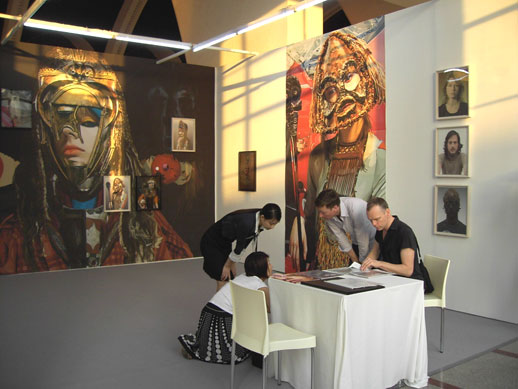
We think that this is one of the best, if not the best art fair ever held in China. Is that due to the strong Western influence?
No, I don’t think so. Fortunately, we have a lot of experience. My partners have been in the market for a very long time now, just like myself, and we know how an art fair has to be done. But what counts is that we have a vision. I think that many many organisers of art fairs in this world – and that’s not a question of whether they are from China or not – try to surf on the wave that we have now, and do not try to reinvent themselves; they do the same again and again. But what is really special here is that this fair has a completely different vision and a completely different conception. First of all, there is no other fair to date that has really tried to show what is on offer here in Asia, in the entirety of Asia, and not only what is fashionable or marketable. It’s a show – and I think this is unique worldwide – where the organisers take a certain responsibility for the content. We say “we want to show this and this… because it’s good”. We have curated spaces, and galleries even want to show in the main hall where we speak and drink coffee.
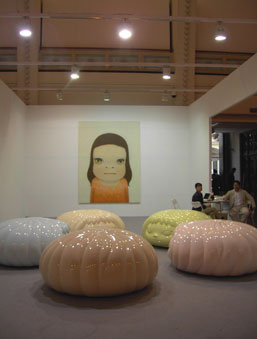
Asian collectors are very self-confident buyers and want to push their preferred artists to the top of the global art league. Can this development also be seen as a cultural competition that reflects proud nations that do not only grow economically? Nations that can also compete culturally and aesthetically with the West?
First of all, I don’t think that it’s only Asian collectors who try to push their artists to the top of the market. That’s a worldwide phenomenon. And in the end, we want to arrive at a situation where we are not speaking about Chinese artists anymore, or about Chinese collectors trying to push Chinese artists… Chinese art will become as recognised as American art, German art, Swiss art… Even when I am saying this, I feel quite strange. In Europe, I would never speak about German art, Swiss art or American art. At the end, you have good art and bad art.
So it doesn’t matter. The origin of the art is completely irrelevant?Right. Everyone has their roots, that’s clear, but at the end, the language is the same.However, when I was reading up in preparation for this interview, I noticed that you yourself were somehow forced into this “national thinking”. I remember, 15 years ago, everybody was talking about Russian art…
You create trends in this market. And to create a trend or to market a trend, you must try to make a beautiful package. There was the Russian art, and then it’s the Leipzig school or whatever. But in the end, 10 years later, you want to have good artists, good names…
Location is a big issue in creating a top art fair, both in terms of geography and architecture. Think of Frieze’s magical tent or the magnificent Grand Palais at FIAC. Basel and Basel Miami profit from their locations in small villages, which they turn into a big playground. Did you have these things in mind when you choose specifically this city in Asia and this marvellous landmark building with its distinctive Stalinistic style?
First of all, there was the question of where in Asia to do this fair. We decided quite quickly it would be China because China is at the peak of its market potential, which is bigger here than anywhere else. And we chose Shanghai because Shanghai is not only a city which focuses on art but which also offers a special lifestyle. Nowadays, at important art fairs, collectors are not only looking for an exhibition, they are looking for an entire package. They want to have fun, they want to feel good, they want to have a lot of possibilities, and I think no other city in China can offer all this as well as Shanghai does. And also the openness and friendliness of this city is quite attractive. As a harbour city, it’s also a gate from China to the world. And when we saw this building, it was clear: It cannot be at any other place. It had to be here: everybody who enters this building is wowed. And it’s also interesting to play this game with contemporary art and architectural ambience. It was quite difficult to play or to make a design, a layout that respects both sides without killing either of them. I think it went very well. Besides, the Grand Palais… Well, I am not so sure about the beauty of that building for a contemporary art fair. And the Magical Tent in London? It’s magical as long as it’s not raining on your head.
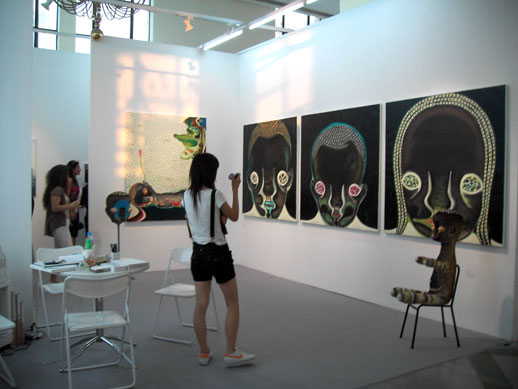
Besides location you also have to keep track of other major art events? As we are aware the preview of the Istanbul Biennale opened Sept. 6th. Did you take other biennials into account when choosing the best time for ShContemporary?
I think nowadays we have a market for an art scene with a lot of important events. Biennials are surely very important events, but we have to look at the entire art scene. There is also a Shanghai Biennial, and it is developing more and more to the leading biennial in Asia. And, for example, next year there will be a parallel between the Shanghai fair and the Shanghai Biennial. The two events will open on two consecutive days, so they will really cooperate and profit from each other; you’ll be able to see both. But at the beginning, we had to sell a vision, a beautiful idea. We had no product to show until now, and that may also be the reason why not everybody came yet. Now we have a product, now we can show what we did. And with the combination of fair and biennial, I am sure that, next year, we will have a tremendous event. “Miami-like”, if you will.China has had a difficult past in dealing with culture. How do you get along with the authorities? Has there been any kind of iconoclastic controversies?
It’s clear that it’s a completey different world and a completely different mentality we are bringing here. We cannot come and say “we are the best; we show you what you have to do”. It has to be a dialogue, an exchange. You have to respect the point of view they have before you offer another point of view. It’s a question of how we treat each other. Sometimes, the way to the goal was clearly not always the shortest, and we made a lot of turns but at the end, like everywhere else, we found a solution together. It’s the same with the authorities. Now they see what it is. Now they have confidence, they do not have any reason left to fear that something new would happen. Of course, we always have discussions – that’s how it is in such situations – but all the discussions ended in really fair, peaceful and comprehensible solutions.
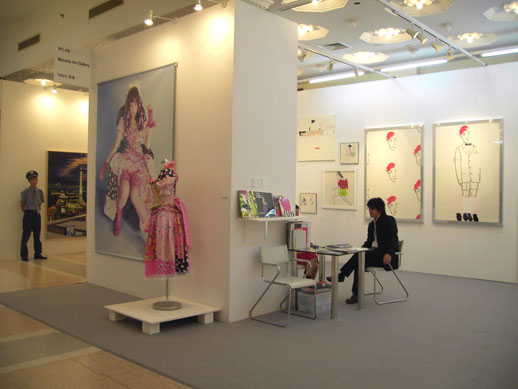
Kosuke Fujitaka from Tokyo Art Beat asked the Japanese galleries about the structure of the collectors and heard that they haven’t had any real contact with Chinese mainland collectors. Do you think that the Chinese collectors prefer to buy from Chinese galleries?
I heard a similar complaint from Chinese galleries; they were saying the same thing about western galleries! I think it’s like every art fair. Certain people have contacts and certain people don’t. This will probably improve with the next years. Chinese collectors, like western collectors, when they first look around, have to build up a certain relationship with the galleries. There were surely cases where Japanese galleries didn’t have contact with Chinese collectors. It’s the same vice versa. But if you do an art fair, it doesn’t matter where you do it, it’s always the same: you should not think that you have conquered the world after one step. You have to build up. And what I see is that Chinese collectors are more and more open-minded and not only focussed on Chinese artists. I think that also Japanese galleries in the future will have great contact with Chinese collectors.
You are a respectable fair director; you have a very strong curatorial and artistic position at your site with Pierre Huber and also with Silvia Evangelisti from ArteFiera, plus a bunch of Shanghai culture associations and committees under Fang Jun the president. Can you tell us how this powerful network evolved? Who initiated the whole thing by bringing all these institutions together?
To cut a very long story short: Pierre and I have known each other for a very long time. When I was the director in Basel, I wanted to change the concept. I created something like a strategic board in 1991. We changed the entire structure of the Basel art fair in the following two, three years in the 1990s. Now it’s the Basel concept, and that concept is copied everywhere in the world. Since then, I got to know Pierre very well. When I left Basel and went to other places, I was always reflecting on the market, and a lot of things changed. I met Pierre again, three years ago. In the course of our discussions, we realised that we were analysing the situation and understanding the development of the market in an absolutely identical way. So we said “ok, we should do something”, and that was the start. We really analysed the entire market for an entire year and developed a concept. Then, I brought in Bologna because we needed a partner who was really operationally able to do such an event. Why Bologna? They know how to do an art fair, they do fairs all over the world, even in China. They have an infrastructure here, they have the necessary networks here. Without this infrastructure, you would never be able to build something up here. So we had a constellation of three partners who were really complementing each other. Me, the art fair manager, Pierre from the side of the collectors and dealers, the artistic part, and BolognaFiere as the operational part. And then of course, we were working together with Chinese partners. We had a lot of possibilities, but mainly thanks to the right local partner. You know, if you do something in China, the most important thing is that you have the right partner: a partner who is strong, and in whom you have confidence. Because, whatever you do, you need a license, and the license is given to a Chinese company. So at the end, it was up to Bologna, on the advice of many, many friends and supporters here in China, to tell us that “that’s the right partner”. So we built up this partnership, mainly thanks to Bologna, because they were already installed here.
To watch a video of this interview, click here.
Aneta Glinkowska
Aneta Glinkowska



